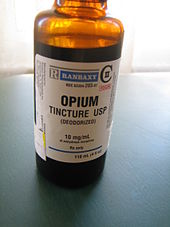
Methadone (also known as Symoron, Dolophine, Amidone, Methadose, Physeptone, Heptadon and many other names) is a synthetic opioid. It is used medically as an analgesic and a maintenance anti- addictive and reductive preparation for use by patients with opioid dependency. It was developed in Germany in 1937, mainly because Germany required a reliable internal source of opiates. Because it is an acyclic analog of morphine or heroin, methadone acts on the same opioid receptors as these drugs, and thus has many of the same effects. Methadone is also used in managing severe chronic pain, owing to its long duration of action, extremely powerful effects, and very low cost. Methadone was introduced into the United States in 1947 by Eli Lilly and Company. Abuse of methadone results in about 5,000 overdose deaths per year in the United States
Methadone is mainly used in the treatment of opioid dependence. It has cross-tolerance (tolerance to similar drugs) with other opioids including heroin and morphine, and offers very similar effects, but a longer duration of effect. Oral doses of methadone can stabilize patients by mitigating opioid withdrawal syndrome or making it more tolerable. Higher doses of methadone can block the euphoric effects of heroin, morphine, and similar drugs. As a result, properly dosed methadone patients can reduce or stop altogether their use of these substances.
Methadone is approved for different indications in different countries. Common is approval as an analgesic and approval for the treatment of opioid dependence. It is not intended to reduce the use of non-opioid drugs such as methamphetamine, or alcohol.
A number of pharmaceutical companies produce and distribute methadone.
Laudanum /ˈlɔːd(ə)nəm/ is a tincture of opium containing approximately 10% powdered opium by weight (the equivalent of 1%morphine).
It is reddish-brown in color and tastes extremely bitter. Laudanum contains almost all of the opium alkaloids, including morphine andcodeine. A potent narcotic by virtue of its high morphine concentration, laudanum was historically used to treat a variety of ailments, but its principal use was as an analgesic and cough suppressant. Until the early 20th century, laudanum was sold without aprescription and was a constituent of many patent medicines. Today, laudanum is recognized as addictive and is strictly regulated and controlled throughout most of the world.
Laudanum is known as a "whole opium" preparation since it historically contained all the opium alkaloids. Today, however, the drug is often processed to remove all or most of the noscapine (also narcotine) present as this is a strong emetic and does not add appreciably to the analgesic or anti-propulsive properties of opium; the resulting solution is called Denarcotized Tincture of Opium or Deodorized Tincture of Opium (DTO).
Laudanum remains available by prescription in the United States and theoretically in the United Kingdom, although today the drug's therapeutic indications are generally confined to controlling diarrhea, alleviating pain, and easing withdrawal symptoms in infants born to mothers addicted to heroin or other opioids. Recent enforcement action by the FDA against manufacturers of paregoric and opium tincture suggests that opium tincture's availability in the U.S. may be in jeopardy.
The terms laudanum and tincture of opium are generally interchangeable, but in contemporary medical practice the latter is used almost exclusively.
Source: Wikipedia
- تعداد بازدید از این مطلب :
900